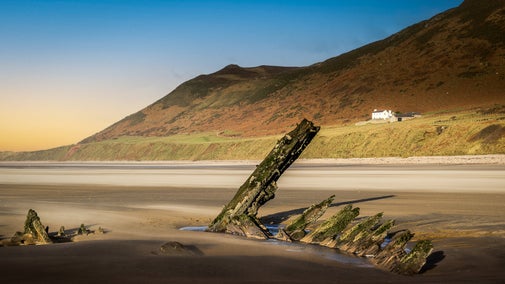
Become a member
Join today and help protect nature, beauty and history – for everyone, for ever. Enjoy access to more than 500 places with National Trust membership.
The quiet north Gower coast with its extensive saltmarsh and dunes
Swansea

| Asset | Opening time |
|---|---|
| Countryside | Dawn - Dusk |
Dogs must be kept on a short lead around livestock.
Car park in village (not National Trust), tarmac path to Cwm Ivy which turns to rough footpath and then walk through sand dunes to the beach. No toilets.
Some parts may not be suitable for pushchairs.
Miles of sandy beach with far reaching views across Burry Port.
Tidal salt marsh bursting with flora and fauna.
Cwm Ivy has undergone a transformational change since the sea wall breached in 2014. Find out more about this process and the reasons behind it happening.

Take a stroll around a newly developing salt marsh at Cwm Ivy on the coast of North Gower and see what birds and wildlife you can spot.

Take a relaxing walk around Welshmoor to explore the home of marsh fritillaries, green hairstreak butterflies and narrow-bordered bee hawk-moths


A modern farmhouse perfectly placed for exploring the Gower Peninsula.

Dramatic sea views and cliff-top walks in all directions make this cottage a must-visit.

Just metres from the world-famous beach at Rhosili Bay, this cottage offers a unique stay on the Gower Peninsula.

A serene stay among pine woodlands, just a short walk to the sand dunes of Whiteford Burrows.

A fully accessible woodland bunkhouse on the Gower Peninsular with views across Whiteford Burrows National Nature Reserve.
Sorry, there are no upcoming events at this place
North Gower is a tranquil place, for quiet enjoyment, bird watching and walking. Much of the north coast is a large expanse of saltmarsh, which is an ever-changing landscape of mudflats and tidal ditches. Along with Whiteford Burrows, it is an internationally important feeding ground for wading birds and wildfowl. The Bulwark is an Iron Age hill fort, found at the top of Llanmadoc Hill. From here there are impressive views across Gower and to the sea beyond. Ryers Down is an open heathland that can be seen from Llanmadoc Hill. It is home to some rare and unusual animals, insects and plants.
Find out about wildlife and our work at Cwm Ivy salt marsh in Whiteford and North Gower, from monitoring rare species to learning about the favourite food of otters.


Join today and help protect nature, beauty and history – for everyone, for ever. Enjoy access to more than 500 places with National Trust membership.
By sharing your email address you’re agreeing to receive marketing emails from the National Trust and confirm you’re 18 years old or over. Please see our for more information on how we look after your personal data.